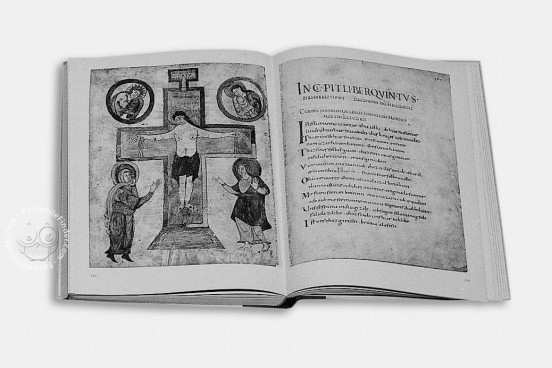Created around 871 in the monastery of Weissenburg, the Evangelienbuch of Otfrid of Weissenburg is one of the earliest known literary works written in Old High German. It reflects the interest Carolingian scholars had in exploring the Christian faith through creative departures from the canonical texts. This volume, written in Caroline minuscule and including three illustrations, was the product of the author’s own community and includes corrections in his own hand.
Otfrid of Weissenburg is considered the first poet of the German language. The Evangelienbuch, or Gospel Harmonies, is a collection of 7,104 couplets. Each verse is demarcated with a rubricated capital. These are arranged into five books, each focused on a period of the life of Christ beginning with the Nativity in the first book and ending with Judgment Day in the last. Otfrid explains this in a letter included in the work. The innovative vernacular verses proved to be popular and several copies survive, however this manuscript provides the authoritative version.
The First German Poet to Compose in Rhyme
Otfrid of Weissenburg was born circa 800 and lived as a monk in the abbey of Weissenburg, modern-day Wissembourg in France near the German border. He was a student of Hrabanus Maurus in Fulda. He composed his Evangelienbuch in the last years of his life in the 860s. Although monastic life would have been focused on reading and writing Latin, Otfrid’s verses are written in the South Rhine Franconian dialect of Old High German. Previous Germanic poetry was made up of alliterative couplets with the occasional rhyme. Otfrid departed from this by forming rhyming couplets, which he claimed were inspired by an “obscene song of the laity.”
Four Scribes and One Illuminator
Rather than being a personal project, the Evangelienbuch appears to have been created by the monastic scriptorium as there are four distinct hands involved in its projection in addition to marginalia and corrections, which may be Otfrid’s hand. The three pictures, the Entry into Jerusalem, the Last Supper and the Crucifixion, are rather naïve in style but demonstrate awareness of the typical iconography of the time. They are not out of place as the subject matter of the couplets is the life of Christ and the Passion cycle.
Three Dedications
Otfrid included a dedicatory inscription in his novel work. The first listed is Louis the German, the first king of East Francia (r. 843-876) and this is the only dedication in Old High German. The rest are in Latin to Solomon I, Bishop of Constance (835-871) and to his monastic brothers, Hartmuat and Werinbert. Also included is a letter in Latin to Liutbert, Archbishop of Mainz (863-889) in which Otfrid explains the nature of his work. These dedications allow for a strict date for the manuscript between 863 and 871. The later life of the book is unknown. It appears to have remained in Wissembourg through the fifteenth century and turned up in Vienna by 1576.
We have 1 facsimile edition of the manuscript "Otfrid von Weissenburg: Gospel harmony": Otfrid von Weißenburg: Evangelienharmonie facsimile edition, published by Akademische Druck- u. Verlagsanstalt (ADEVA), 1972
Request Info / Price
